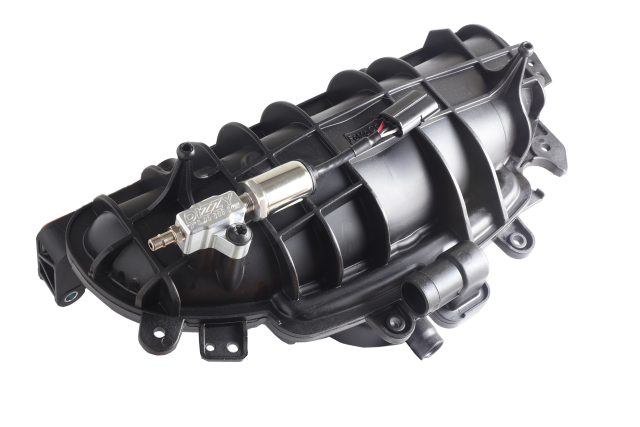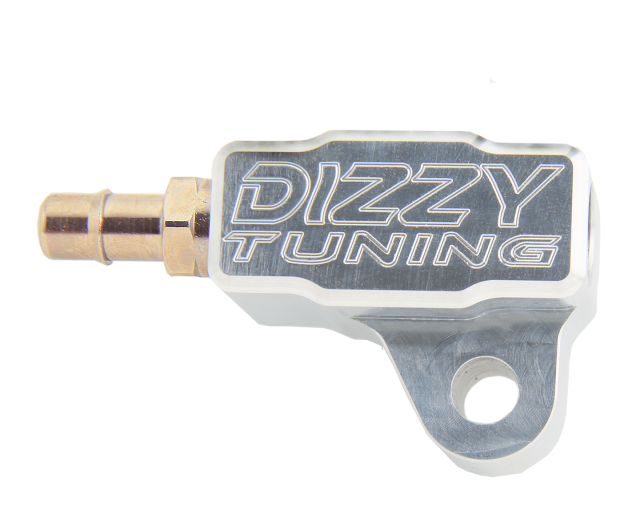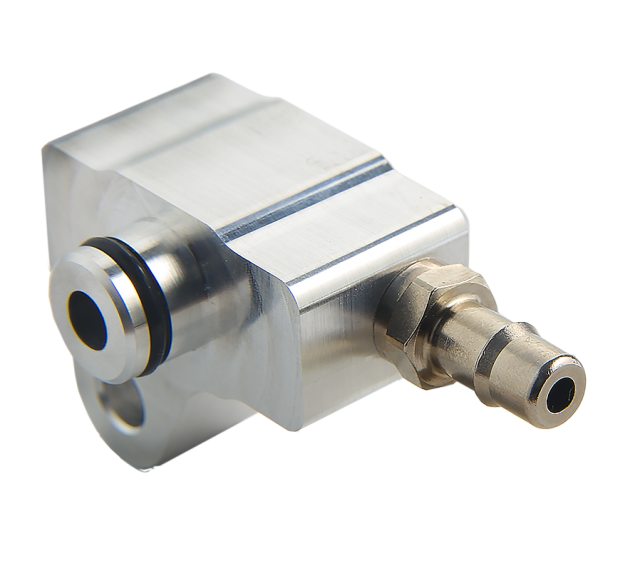Map Sensor Adapters are in stock and ready to ship!
Ron at Whoosh Motorsorts is also a stocking Dealer.
https://dizzytuning.com/collections...nsor-adapter-for-ford-fiesta-st-1-6l-ecoboost



From the Dizzy Tuning Tech Blog:
Why would I want to replace the MAP Sensor in my Fiesta ST? There are actually a few reasons:
First, the OEM MAP Sensor is a 3 Bar Sensor and can accurately read up to 29.xx PSI. So if you are running below this pressure on your current setup, then this upgrade may not be necessary. But for anyone running over this pressure, knows that the “Boost” monitor on the Accessport can no longer be used to monitor pressure. Common practice is to upgrade the TMAP Sensor in the cold pipe with the Bosch 3.5 Bar unit, and now monitor “TIP Actual” for our boost pressure readings. As I have said in previous posts, this is not an accurate representation of the PSI that is currently in the manifold and being ingested into the engine. The only way to read this pressure accurately is to upgrade the MAP Sensor.
Second, the Fiesta ST ECU is “Speed Density” based. So all airflow/AFR calculations are based off different engine sensors like air temperature, barometric pressure, and manifold pressure (MAP). So having accurate boost (MAP) readings at all times is crucial for proper fueling calculations. Here is an example; if we have an engine with all the supporting modifications, running 30 psi at 3,500 RPM and increasing slightly up to 32 psi by redline. But this engine is running the OEM MAP sensor, which cannot read higher than 29.xx PSI. What will happen is the MAP sensor will peg at 29.xx PSI, and stay there for the duration of the pull, until boost comes back into operation range of the sensor. So applying this info into what we know about Speed Density airflow calculations, AFR will not be calculated correctly. The engine is physically ingesting 32 PSI, while the sensor is only reading and telling the ECU to fuel for 29 PSI. There are a lot of other calculations that come into play here, but this is a very simple representation for everyone to understand fairly easily.
Lastly, Aux Fuel tuning. All Aux Fuel kits come with a fuel controller to control the injector(s). The controllers function based off of (2) inputs, RPM and MAP voltage. The Split Second software consists of a 3D fuel table with RPM down the y-axis and MAP voltage across the x-axis. Again, using your above engine as an example, and knowing that the OEM MAP sensor will be pegged for the duration of the pull, that means that we are locked into one column of the x-axis (MAP voltage), for the duration of the pull. Voltage will increase to 4.75-4.85v (max sensor voltage), and stay there. Again, this is not ideal for proper fuel tuning. With an upgraded sensor that can read higher pressures, we are now within the normal operating range of the sensor at all times. An even further benefit here, is that given for “x” amount of voltage (PSI), we can fuel the engine with “x” amount of fuel, and with “y” amount of PSI, we an fuel the engine with “y” amount of fuel. I am still testing this on my Fiesta, but my hope is that with the proper hardware configuration, we can run separate boost maps (high boost, eco, etc), or even varying fuel-type maps, all on the same fuel map! More data on this to come!
Where can I get a replacement MAP Sensor? To this date, I have yet to locate a replacement MAP Sensor, that will fit in the manifold, and read a higher pressure than the OEM 3 Bar sensor. Bosch does not disclose most of their Part Numbers, catalogues, or datasheets, so it made it very difficult to locate the proper sensor to get the job done. But I wasn't stopping there.
AEM sensors are well known on the Automotive Performance Industry for both accuracy and reliability. So it was a pretty obvious replacement option. The only problem is that these sensors mount a bit differently than the OEM sensor. They thread into an 1/8" NPT port, rather than the held in with a securing bolt, like the Bosch units. These sensors are available in a few PSI-range options, but the one I am suggesting for the Fiesta ST is the 50 PSIa unit (Part Number 30-2130-50). 50PSIa (absolute) equates to 35.3 PSI of boost pressure.
Source:
https://whoosh-motorsports.myshopif...sta-parts/products/aem-3-5-bar-map-sensor-kit
How do I install the new MAP Sensor? This adapter will fit in the manifold, just like a “map tap”, and have the port needed for the new Map Sensor. Since most users running this amount of boost are more than likely running a boost-operated BOV, there is also an air port on the adapter, as well. Add PnP pigtail for Plug And Play installation!
**Tuning for the new MAP Sensor is required!**
**AEM Map Sensor not included**
Ron at Whoosh Motorsorts is also a stocking Dealer.
https://dizzytuning.com/collections...nsor-adapter-for-ford-fiesta-st-1-6l-ecoboost



From the Dizzy Tuning Tech Blog:
Why would I want to replace the MAP Sensor in my Fiesta ST? There are actually a few reasons:
First, the OEM MAP Sensor is a 3 Bar Sensor and can accurately read up to 29.xx PSI. So if you are running below this pressure on your current setup, then this upgrade may not be necessary. But for anyone running over this pressure, knows that the “Boost” monitor on the Accessport can no longer be used to monitor pressure. Common practice is to upgrade the TMAP Sensor in the cold pipe with the Bosch 3.5 Bar unit, and now monitor “TIP Actual” for our boost pressure readings. As I have said in previous posts, this is not an accurate representation of the PSI that is currently in the manifold and being ingested into the engine. The only way to read this pressure accurately is to upgrade the MAP Sensor.
Second, the Fiesta ST ECU is “Speed Density” based. So all airflow/AFR calculations are based off different engine sensors like air temperature, barometric pressure, and manifold pressure (MAP). So having accurate boost (MAP) readings at all times is crucial for proper fueling calculations. Here is an example; if we have an engine with all the supporting modifications, running 30 psi at 3,500 RPM and increasing slightly up to 32 psi by redline. But this engine is running the OEM MAP sensor, which cannot read higher than 29.xx PSI. What will happen is the MAP sensor will peg at 29.xx PSI, and stay there for the duration of the pull, until boost comes back into operation range of the sensor. So applying this info into what we know about Speed Density airflow calculations, AFR will not be calculated correctly. The engine is physically ingesting 32 PSI, while the sensor is only reading and telling the ECU to fuel for 29 PSI. There are a lot of other calculations that come into play here, but this is a very simple representation for everyone to understand fairly easily.
Lastly, Aux Fuel tuning. All Aux Fuel kits come with a fuel controller to control the injector(s). The controllers function based off of (2) inputs, RPM and MAP voltage. The Split Second software consists of a 3D fuel table with RPM down the y-axis and MAP voltage across the x-axis. Again, using your above engine as an example, and knowing that the OEM MAP sensor will be pegged for the duration of the pull, that means that we are locked into one column of the x-axis (MAP voltage), for the duration of the pull. Voltage will increase to 4.75-4.85v (max sensor voltage), and stay there. Again, this is not ideal for proper fuel tuning. With an upgraded sensor that can read higher pressures, we are now within the normal operating range of the sensor at all times. An even further benefit here, is that given for “x” amount of voltage (PSI), we can fuel the engine with “x” amount of fuel, and with “y” amount of PSI, we an fuel the engine with “y” amount of fuel. I am still testing this on my Fiesta, but my hope is that with the proper hardware configuration, we can run separate boost maps (high boost, eco, etc), or even varying fuel-type maps, all on the same fuel map! More data on this to come!
Where can I get a replacement MAP Sensor? To this date, I have yet to locate a replacement MAP Sensor, that will fit in the manifold, and read a higher pressure than the OEM 3 Bar sensor. Bosch does not disclose most of their Part Numbers, catalogues, or datasheets, so it made it very difficult to locate the proper sensor to get the job done. But I wasn't stopping there.
AEM sensors are well known on the Automotive Performance Industry for both accuracy and reliability. So it was a pretty obvious replacement option. The only problem is that these sensors mount a bit differently than the OEM sensor. They thread into an 1/8" NPT port, rather than the held in with a securing bolt, like the Bosch units. These sensors are available in a few PSI-range options, but the one I am suggesting for the Fiesta ST is the 50 PSIa unit (Part Number 30-2130-50). 50PSIa (absolute) equates to 35.3 PSI of boost pressure.
Source:
https://whoosh-motorsports.myshopif...sta-parts/products/aem-3-5-bar-map-sensor-kit
How do I install the new MAP Sensor? This adapter will fit in the manifold, just like a “map tap”, and have the port needed for the new Map Sensor. Since most users running this amount of boost are more than likely running a boost-operated BOV, there is also an air port on the adapter, as well. Add PnP pigtail for Plug And Play installation!
**Tuning for the new MAP Sensor is required!**
**AEM Map Sensor not included**
- Fits 2014-2019 Fiesta ST 1.6L Ecoboost
- Allows Use of AEM Map Sensor
- Add Pigtail for PnP Installation
- 1/4" Hose Barb for Pressure Actuated BOV's
- Designed and Manufactured in the USA
- 1 Year Warranty
